
Uggleviksreservoaren
Encyclopedia

Water reservoir
A reservoir , artificial lake or dam is used to store water.Reservoirs may be created in river valleys by the construction of a dam or may be built by excavation in the ground or by conventional construction techniques such as brickwork or cast concrete.The term reservoir may also be used to...
located in the forest Lilljansskogen near Uggleviken
Uggleviken
Uggleviken is a former bay and lake at Norra Djurgården, a rural area in north-eastern central Stockholm, Sweden, forming part of the national city park Ekoparken....
, a fen
Fen
A fen is a type of wetland fed by mineral-rich surface water or groundwater. Fens are characterised by their water chemistry, which is neutral or alkaline, with relatively high dissolved mineral levels but few other plant nutrients...
at Norra Djurgården in north-eastern central Stockholm
Stockholm
Stockholm is the capital and the largest city of Sweden and constitutes the most populated urban area in Scandinavia. Stockholm is the most populous city in Sweden, with a population of 851,155 in the municipality , 1.37 million in the urban area , and around 2.1 million in the metropolitan area...
, Sweden
Sweden
Sweden , officially the Kingdom of Sweden , is a Nordic country on the Scandinavian Peninsula in Northern Europe. Sweden borders with Norway and Finland and is connected to Denmark by a bridge-tunnel across the Öresund....
.
The concrete structure, design by architect Paul Hedqvist
Paul Hedqvist
Paul Hedqvist was a Swedish modernist architect with many official commissions in Sweden through the 1930s, including housing projects, major bridges, many schools, and urban planning work. His practice evolved into designing office towers and at least one major stadium in the postwar 1950s...
and built in 1935, is composed of 64 pillars carrying the uninsulated tank crowned by a small lantern. One of the most prominent landmarks in central Stockholm observable from elevated locations kilometres away, the classical structure has a monumentality further amplified by its elevated location in a forest remote from any other buildings. It is one of few remaining, visible traces of the ambitious municipal projects carried through in the early 20th century, still witnessing the restraints and possibilities of casting techniques anticipating pre-stressed concrete and slipform constructions.

